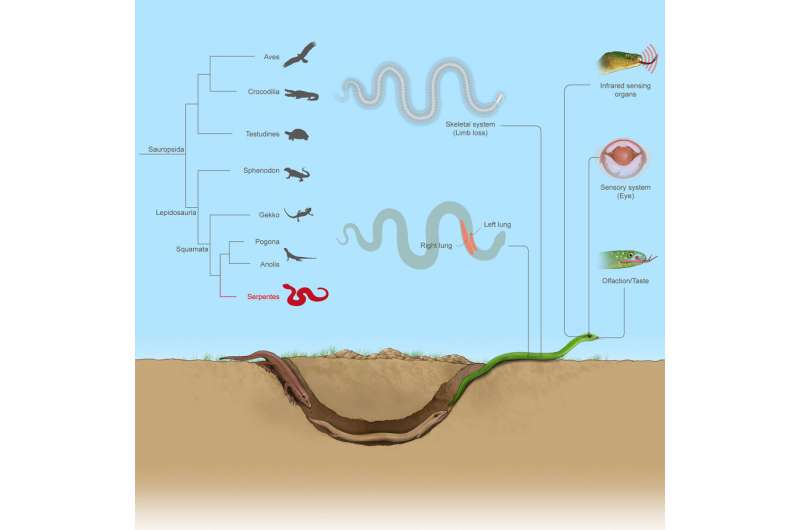June 21, 2023 report
This article has been reviewed according to Science X's editorial process and policies. Editors have highlighted the following attributes while ensuring the content's credibility:
fact-checked
peer-reviewed publication
trusted source
proofread
Snake genome reveals burrowing past and re-adaptation to surface life

Chromosome-level assembly of 14 snakes in a study led by the Chinese Academy of Sciences, China, has created a high-resolution genomic reference for the study of snake evolution. In a paper, "Large-scale snake genome analyses provide insights into vertebrate development," published in Cell, the research team details a wide array of discoveries already made by their sequencing data.
Using the long read ability of sequencers from PacBio and Oxford Nanopore Technology, researchers were able to craft a good draft of the whole genome for 14 snakes from 12 different families. The team then used BGI and Illumina platform sequencers that obtain shorter read lengths with higher quality. The reads were then assembled at the chromosome level using Hi-C read data.
The researchers then analyzed the data they collected along with previously sequenced genomes of snakes, lizards, a turtle, a crocodile, a bird and a mouse. A picture of snake evolution was constructed from various trait-related gene losses, additions and conservations.
Estimated divergence times based on the analysis suggests that snakes originated during the Early Cretaceous around 118 million years ago and underwent rapid diversification after the mass extinction event 65 million years ago.
The signature traits of a long legless body were consistent with snake-specific gene deletions observed in all newly sequenced snake genomes.
The elongated body of snakes also affects the shape of internal organs like the lungs. The left lung is typically absent, residual, or working but smaller than the right lung. A dynein-coding gene that plays a vital role in the development of left-right symmetries was absent in the snakes, and 13 lung development-related genes had insertions that could alter how they regulate lung development.
Changes in the visual system were seen in several lost photoreceptor-related coding genes. The expression of 15 photoreceptor cell-related genes was significantly up-regulated in snake eyes. The authors suggest that early snakes underwent a prolonged low-light burrowing period before returning to well-lit surface habitats. In this scenario, the structure and function of the snake eyes would have re-adapted to surface light by upregulating the genes that had been conserved.
Three lineages of snakes—pit vipers, pythons, and boas—all possess specialized temperature-sensitive infrared-sensing organs with a trigeminal nerve. The analysis revealed a convergent repurposing of non-coding genes around active genes with a cellular response to heat.
Observations of genes regulating hearing suggest that gene loss is connected to snakes' lack of hearing range and some sound perception. At the same time, the evolution of additional gene regulators could relate to inner ear specialization and low-frequency hearing. This shift in hearing is also commonly seen in burrowing animals, further suggesting a previous subterranean ancestry.
Aside from the insights into snake evolution and diversification, the high-quality data collection has been made public and will undoubtedly be a relied upon genomic reference source for future research into reptilian biology.
More information: Changjun Peng et al, Large-scale snake genome analyses provide insights into vertebrate development, Cell (2023). DOI: 10.1016/j.cell.2023.05.030
Journal information: Cell
© 2023 Science X Network




















